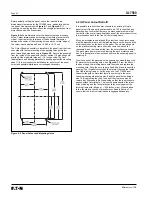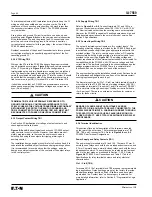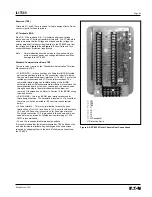
IL17569
Page 8-2
Effective June, 2001
8.3 Overcurrent Functions – Instantaneous
and Time
8.3.1 Instantaneous
The Instantaneous Trip occurs when any of the phase currents
exceeds the pickup current defined by the user. That is:
I
phase
> I
pick up
Instantaneous Trip may be set for a delay from zero (0) to 9999
cycles after the pickup current is exceeded. Since the current is
evaluated twice per cycle, the initiation of the trip action begins
within a cycle for a setting of 0. Completion of the trip depends upon
the usual electromechanical contact output delays in the FP-5000
(included in specification of trip time accuracy) and in the time for
the breaker to open. The FP-5000 provides two timed or instanta-
neous phase trip functions: 50P1 and 50P2. One of the trip
functions can be used as a truly instantaneous with zero delay while
the other can be used as a short delay function.
8.3.2 Inverse Time-Overcurrent Protection (51)
Three families of curves provide inverse time overcurrent protection.
The three families are: Thermal, ANSI and IEC curves. The FP-
5000 provides 10 standard Time overcurrent curves: Flat, It, I
2
t, and
I
4
t for Thermal; Extremely Inverse, Very Inverse and Moderately
Inverse for ANSI; and IEC-C, IEC-B and IEC-A for IEC.
Thermal
Thermal curves include It, I
2
t, I
4
t and FLAT, and are defined by the
following equation:
T = Trip Time in Seconds
D = Time Multiplier Setting
M = Slope (0=FLAT, 1= It, 2=I
2
t, 4=I
4
t)
K = 3 for Phase, 1 for Ground
I
nom
= Nominal Current either 5 or 1 A
I
= Measured Current
ANSI & IEC
The ANSI Moderately Inverse, Very Inverse and Extremely Inverse
curves are defined by ANSI C37.112. The IEC curves are defined by
IEC 255-3. The ANSI and IEC families of curves are defined by the
same equation and differ only in the selection of constants A, B and
P as contained in Table 8.1. The trip time, T, in seconds is defined
by the following equation:
T
= Trip Time in seconds
D
= Time Multiplier Setting
I
pu
= Pickup Current Setting
I
= Measured Current
A, B, P = Constants
Reset
The reset function describes what occurs to the accumulated tally of
the TOC function if the current goes below pickup. The accumulated
tally is similar to how far an induction disk has traveled if an
electromechanical relay was being used. The time delayed reset
function provides improved coordination with electromechanical and
other relays. The reset function is very important if the breaker re-
closes quickly after tripping. The FP-5000 allows a choice of three
different reset functions:
Instantaneous Reset
– If the current is less than the programmed
pickup current, the accumulated memory is erased.
Time Delay
– This is exactly like the instantaneous reset except the
current must be below pickup for the set number of cycles before
the accumulated memory is removed.
Calculated
– For the thermal curves, the following reset time is
given to zero the accumulated memory:
t = Time to Reset Accumulated Memory
D = Time Multiplier Setting
K = 1 for Ground, 3 for Phase
Notice that the reset time is independent of the magnitude of the
current as long as the current magnitude is below pickup.
The reset function for the ANSI and IEC curves are given in the
following equations defined in ANSI C37.112. The constant t
r
is
defined in Table 8.1.
Gr = See Table 8.1
D = Time Multiplier Setting
I
= Measured Current
I
pu
= Pickup Current Setting
The constants for the indicated curve equations are contained
in Table 8.1.
Summary of Contents for Cutler-Hammer FP-5000
Page 1: ...IL17569 Effective June 2001 Instructions for FP 5000 Protective Relay...
Page 7: ...IL17569 Table of Contents 6 Effective June 2001 This page left blank intentionally...
Page 13: ...IL17569 Page 2 2 Effective June 2001 Figure 2 2 FP 5000 Simple Wye Connected Application...
Page 14: ...Page 2 3 IL17569 Effective June 2001 Figure 2 3 FP 5000 Simple Open Delta Application...
Page 19: ...IL17569 Page 2 8 Effective June 2001 This page left blank intentionally...
Page 25: ...IL17569 Page 3 6 Effective June 2001 This page left blank intentionally...
Page 98: ...IL17569 Page 5 50 Effective June 2001 This page left blank intentionally...
Page 108: ...IL17569 Page 6 10 Effective June 2001 Figure 6 10 Common Ct Wiring Configurations...
Page 141: ...IL17569 Page 11 4 Effective June 2001 This page left blank intentionally...
Page 165: ...IL17569 Page Appendix 6 Effective June 2001 Figure 13 2 ANSI Very Inverse...
Page 166: ...Page Appendix 7 IL17569 Effective June 2001 Figure 13 3 ANSI Extremely Inverse...
Page 167: ...IL17569 Page Appendix 8 Effective June 2001 Figure 13 4 IEC A Figure 13 4 IEC A...
Page 168: ...Page Appendix 9 IL17569 Effective June 2001 Figure 13 5 IEC B...
Page 169: ...IL17569 Page Appendix 10 Effective June 2001 Figure 13 6 IEC C...
Page 170: ...Page Appendix 11 IL17569 Effective June 2001 Figure 13 7 IEC...
Page 171: ...IL17569 Page Appendix 12 Effective June 2001 Figure 13 8 ANSI...
Page 172: ...Page Appendix 13 IL17569 Effective June 2001 Figure 13 9 Thermal...
Page 173: ...IL17569 Page Appendix 14 Effective June 2001 Figure 13 10 Phase I4 t...
Page 174: ...Page Appendix 15 IL17569 Effective June 2001 Figure 13 11 Phase I2 t...
Page 175: ...IL17569 Page Appendix 16 Effective June 2001 Figure 13 12 Phase It...
Page 176: ...Page Appendix 17 IL17569 Effective June 2001 Figure 13 13 Phase 12 I4 t...
Page 177: ...IL17569 Page Appendix 18 Effective June 2001 Figure 13 14 Phase I2 t...
Page 178: ...Page Appendix 19 IL17569 Effective June 2001 Figure 13 15 Ground IT...
Page 180: ...Page Appendix 21 IL17569 Effective June 2001 This page left blank intentionally...
Page 187: ...Publication No IL17569 June 2001 Pittsburgh Pennsylvania U S A...















































